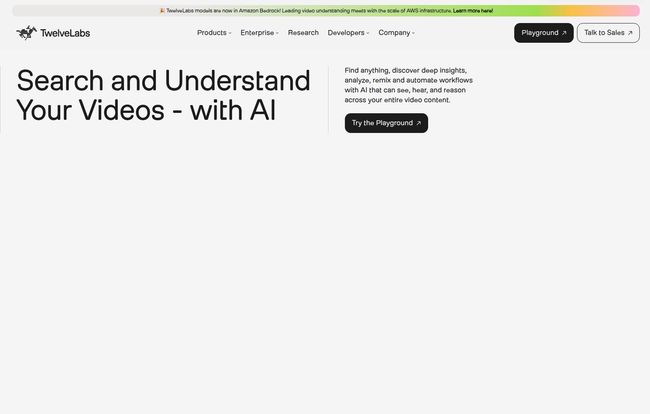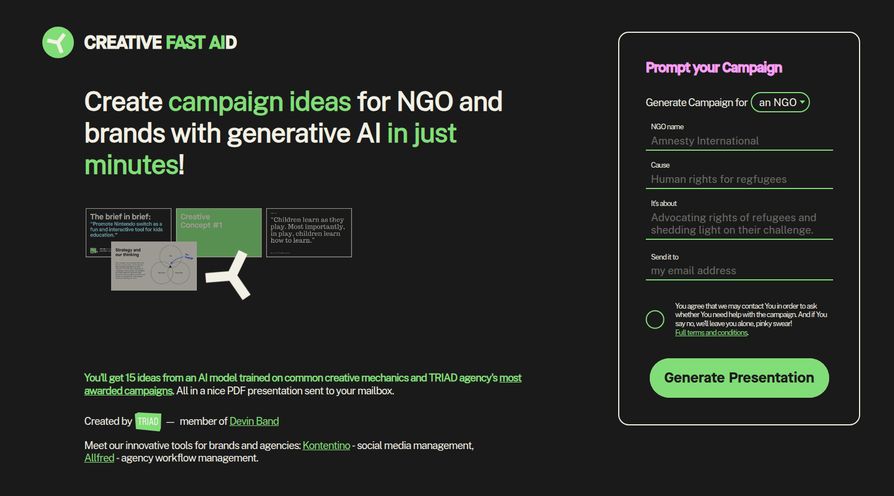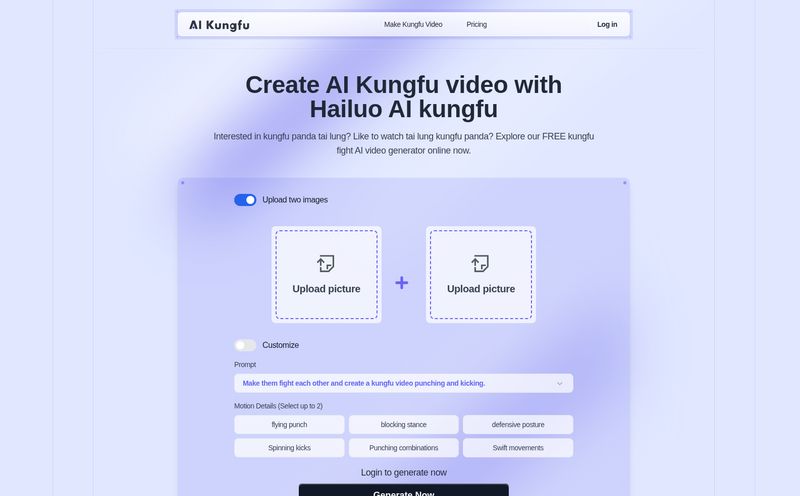We’re all sitting on a mountain of video content. Webinars, product demos, raw interview footage, conference recordings... it’s a digital attic filled with gold, but finding anything specific feels like searching for a single Lego brick in a ball pit. Blindfolded. I've spent more hours than I care to admit scrubbing through timelines, listening at 2x speed, trying to find that one 15-second clip where a client gave the perfect testimonial. It's a soul-crushing, inefficient process.
For years, the promise has been that AI would solve this. And while we’ve gotten decent transcription, true understanding has always felt just out of reach. You could search for the word “revenue,” but you couldn’t search for “the moment the CEO looked optimistic while talking about Q3 projections.”
Well, I think that might be changing. I’ve been playing around with a platform called TwelveLabs, and it feels… different. This isn’t just another transcription tool with a search bar tacked on. It feels like a genuine search engine built for the messy, multimodal world of video. And honestly, I’m pretty excited.
So, What Exactly is TwelveLabs?
At its core, TwelveLabs is an AI-powered video intelligence platform. Forget the jargon for a moment. Think of it like this: you can ask your video library a question, in plain English, and it finds the exact moment you’re looking for. Not just based on spoken words, but on actions, objects, and even concepts.
It’s powered by what they call “multimodal AI.” This is the secret sauce. The AI isn’t just listening to the audio or just watching the visuals; its doing it all at once, understanding the context between them. It sees the person waving, hears them say “hello,” and reads the “Welcome” sign in the background, and understands it all as a single event: a greeting.
This is a fundamental shift from traditional keyword-based systems. It’s the difference between searching a document and having a conversation with someone who actually read the book.

Visit TwelveLabs
Beyond Keywords: The Magic of Multimodal AI
So how does it work? TwelveLabs has developed some seriously powerful foundation models, most notably their Pegasus model. If you’ve been in the AI space, you know that a strong foundation model is everything. They claim it surpasses the benchmarks set by the big cloud players (yeah, Google and AWS) and the popular open-source options. A bold claim, but from what I’ve seen, it holds up.
This AI understands time and space within a video. You can make searches like:
- “Find the clip of a person in a blue shirt walking through a crowded market.”
- “Show me every time a car drives past a specific building.”
- “When does the presenter draw a chart on the whiteboard?”
This capability opens up a world of possibilities that just weren't practical before. It’s one thing to read a transcript; it’s another to instantly pinpoint a visual cue or a specific action. That's where the real value is burried.
The Features That Genuinely Matter
Okay, cool tech is one thing, but how does it actually help us get work done? Here's the breakdown of what I found most impressive.
Natural Language Video Search
This is the headline act. The ability to search your entire video archive using conversational phrases is, frankly, a game-changer. For marketing teams, it means finding the perfect B-roll in seconds. For researchers, it means locating specific moments in recorded interviews without re-watching hours of footage. No more meticulous manual tagging or relying on someone’s fuzzy memory.
Content Analysis and Generation
This is where it gets really interesting for content creators like myself. TwelveLabs can do more than just find stuff; it can analyze and generate text from the video. It can create summaries, chapters, and detailed descriptions. Imagine uploading a one-hour webinar and getting back a ready-to-publish blog post, complete with timestamps for key moments. The time-saving potential is enormous. It's about working smarter, not harder.
Customizable AI Models
Here’s a feature for the real power users and enterprises. You can actually train TwelveLabs models on your own specific data. This is huge for industries with unique jargon or visual identifiers. A medical company could train it to recognize specific surgical instruments, or a manufacturer could teach it to identify different machine parts. This level of customization takes it from a general tool to a bespoke, integrated solution.
Let's Talk Money: Breaking Down the TwelveLabs Pricing
Alright, the all-important question: what’s this going to cost? The pricing structure is thankfully straightforward and tiered, which I appreciate. You’re not locked into a massive contract just to try it out.
You can see the full details on their pricing page, but here's my quick summary:
| Plan | Best For | Cost | Key Features |
|---|---|---|---|
| Free | Testing & Building | $0 | 300 minutes of indexing, limited daily API calls, access to the Marengo model. It's a proper free tier, not just a 7-day trial. |
| Developer | Launching & Growing | Pay-as-you-go | Significantly more API calls, access to the more powerful Pegasus model, pay per minute of video indexed/analyzed. |
| Enterprise | Scaling & Services | Custom | Unlimited everything, custom model training, dedicated support, and advanced security. The full package. |
My take? The Free tier is incredibly generous and perfect for anyone who wants to kick the tires and see if it works for their use case. The Developer plan is the logical next step for startups or businesses integrating this into a product. The pay-as-you-go model is fair, but you'll want to monitor your usage so you dont get a surprise bill.
The Good, The Bad, and The AI-Powered
No tool is perfect, right? Here’s my honest assessment of the pros and cons.
The Good Stuff
The world-class accuracy is the biggest win. It just works, and it works better than many other tools I've tried. The promise of finding a needle in a haystack is actually delivered. The infrastructure is also built to scale, so you can throw petabytes of data at it without worrying. And the ability to customize models and deploy them anywhere (cloud, on-premise) is a massive plus for businesses with specific needs or strict data policies.
The Things to Keep in Mind
The pricing can be variable, especially on the Developer plan. If you have a huge spike in usage, your bill will reflect that. It’s not a flat fee, which requires a bit more management. Also, while the platform is developer-friendly, getting into the deep customization will require some technical know-how. This isn’t necessarily a tool for the completely non-technical user, at least not for its most advanced features. Finally, you're still relying on AI. It’s incredibly accurate, but no AI is 100% perfect 100% of the time. Always good to have a human in the loop for critical applications.
My Final Verdict: Is TwelveLabs Worth It?
In my opinion, yes. Emphatically yes.
TwelveLabs is tackling one of the most significant unsolved problems in content management: making video searchable and useful at scale. It’s not just an incremental improvement; it feels like a genuine leap forward. For any organization that produces or relies on large amounts of video content—from media companies and ad agencies to e-learning platforms and security firms—this tool has the potential to unlock immense value.
It turns your video archive from a cost center, a storage problem, into a valuable, queryable asset. And that’s a very big deal.
Frequently Asked Questions
What's the difference between the Marengo and Pegasus models?
Think of Marengo as the reliable workhorse and Pegasus as the high-performance thoroughbred. Marengo is great for a wide range of general search and analysis tasks and is available on the Free plan. Pegasus is their state-of-the-art, video-first language model that offers superior understanding and nuance for more complex queries, available on the Developer and Enterprise plans.
Can I really train the AI on my company's specific products or jargon?
Yes, you can! This is one of the standout features of the Enterprise plan. You can fine-tune the models by providing your own data, which allows the AI to learn and accurately recognize unique objects, terminology, or environments relevant to your business.
Is the video search really available in any language?
The platform is designed to be language-agnostic for its core multimodal search capabilities. This means it can understand concepts and actions across different languages. For text-based recognition and generation, its capabilities would depend on the specific languages supported, which are continually expanding.
What happens if I go over the limits on the Free plan?
Typically, when you hit the usage limits on a free tier (like the 300 minutes of indexing or 60 daily API calls), your service will be paused or you'll be blocked from making new requests until the next day or billing cycle. You'll receive a prompt or notification encouraging you to upgrade to the Developer plan to continue service without interruption.
How secure is it to upload our private company videos?
Security is a major focus for platforms like this, especially for enterprise clients. While you should always review their specific security and privacy policies, TwelveLabs offers enterprise-grade security features. For maximum control, the Enterprise plan includes options for deployment in a private cloud or even on-premise, ensuring your sensitive data never leaves your own infrastructure.
Conclusion
We've been talking about the potential of video AI for years, but TwelveLabs is one of the first platforms I’ve seen that truly delivers on the promise. It’s well-designed, powerful, and solves a problem that has plagued content teams for over a decade. The video black box is finally being pried open, and we can all see the valuable content that’s been hiding inside. The future of video isn’t just about creating more of it; it's about understanding it. And TwelveLabs is leading the charge.
Reference and Sources
- TwelveLabs Official Website
- TwelveLabs Pricing Page
- A technical paper on Multimodal Learning (for the curious) - ViLT: Vision-and-Language Transformer Without Convolution or Region Supervision



